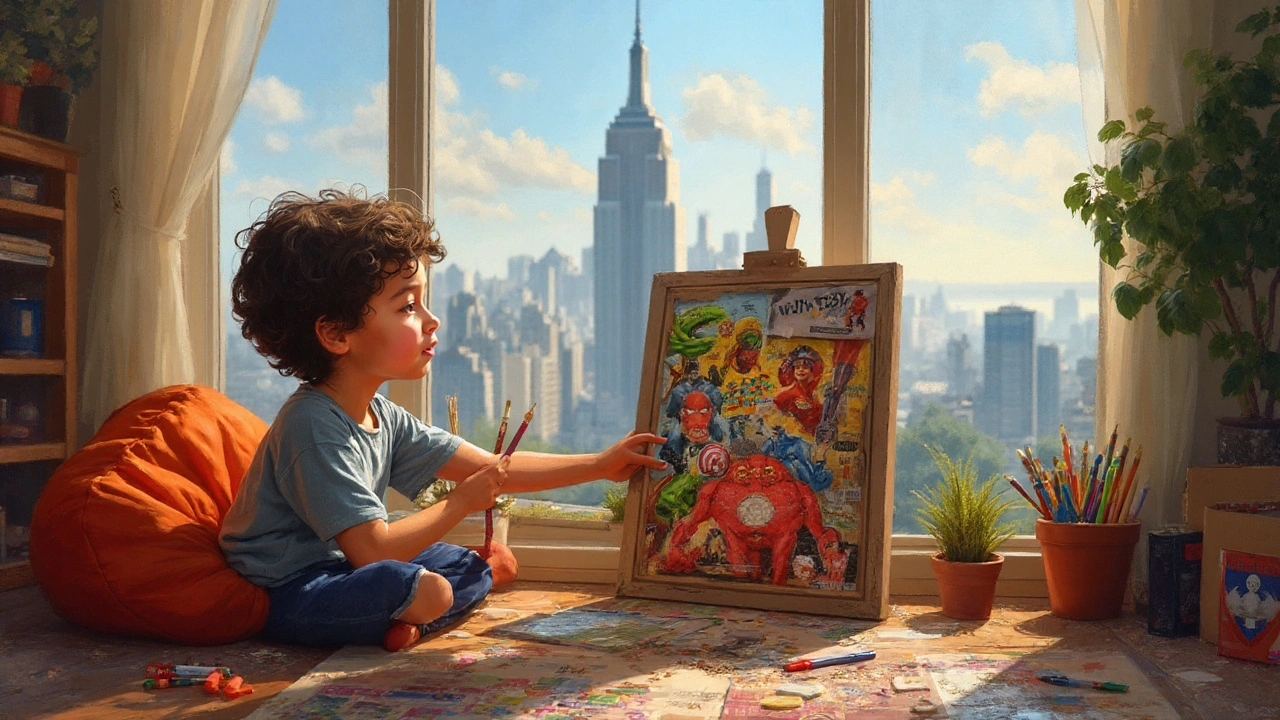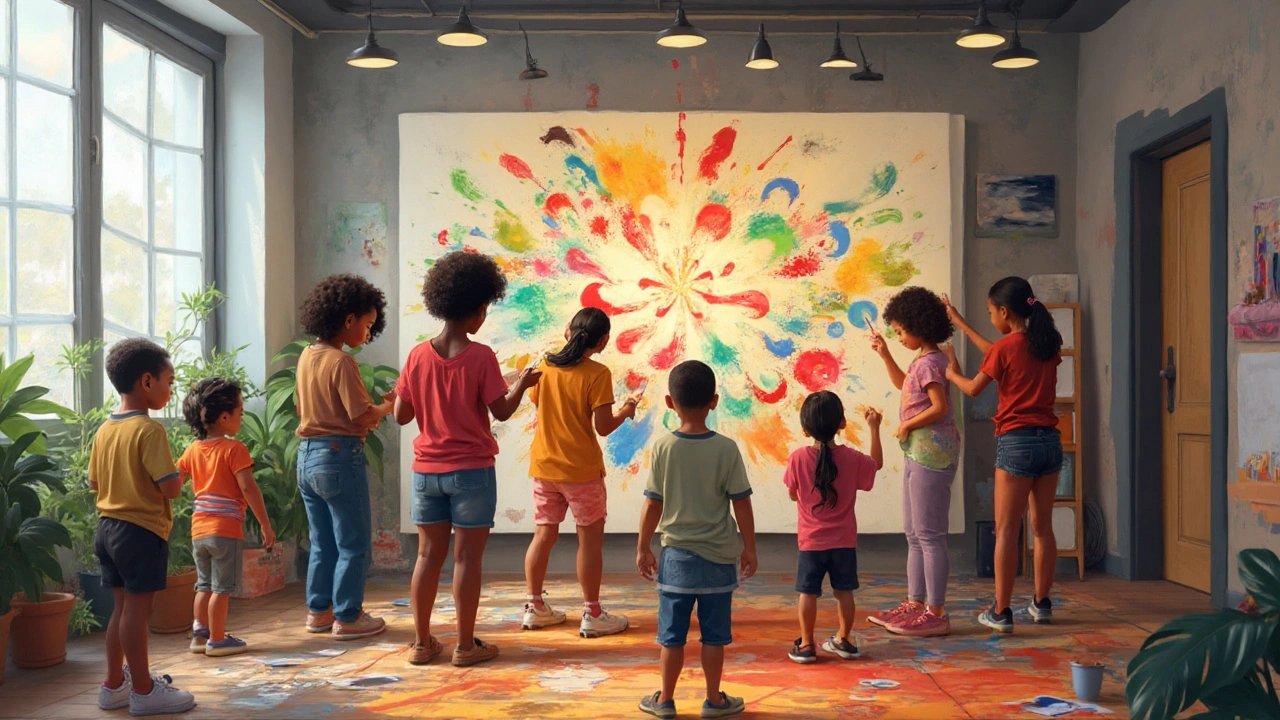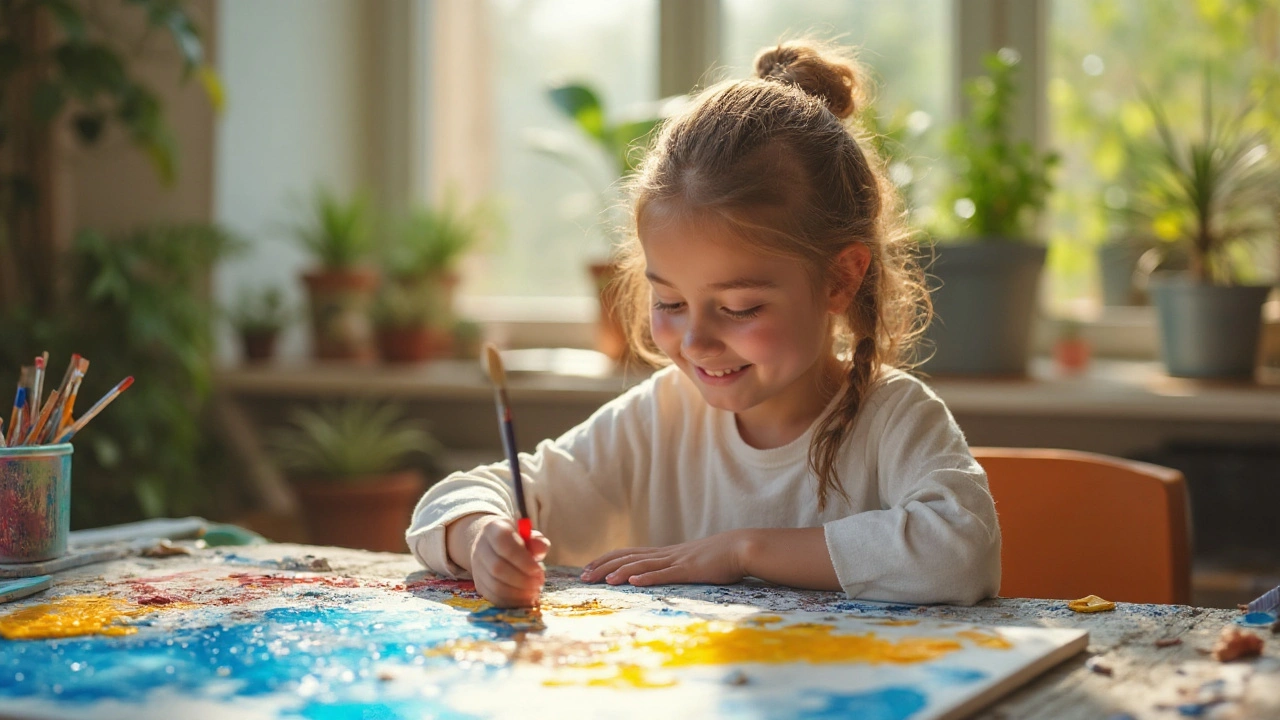Art Therapy is a psychotherapeutic approach that uses visual art‑making to promote mental health and emotional growth. For people with ADHD (Attention‑Deficit/Hyperactivity Disorder, a neurodevelopmental condition characterized by inattention, hyperactivity and impulsivity), the structured yet flexible nature of art sessions offers a rare blend of freedom and focus.
Understanding ADHD and Its Brain Impact
ADHD stems from differences in dopamine regulation and executive‑function networks, especially in the prefrontal cortex. These neurological variations often lead to challenges in planning, time‑management, and emotional self‑control. Recent neuroimaging studies show reduced activity in the default‑mode network during task‑focused moments, which explains why sustained attention feels like a constant uphill battle for many.
Why Creative Expression Works
Creative Expression is the act of translating internal thoughts and feelings into tangible media such as paint, clay, or collage. When a person with ADHD engages in this process, the brain receives sensory feedback that can temporarily boost dopamine levels, mirroring the effect of medication without side‑effects. Moreover, the tactile nature of art taps into Sensory Integration, helping regulate the overstimulation common in hyperactive states.
Core Benefits of Art Therapy for ADHD
- Improved Focus: Repetitive brush strokes require sustained attention, training the brain's attention‑maintenance circuits.
- Enhanced Executive Function (skills like planning, organizing, and self‑monitoring) through project‑based goals.
- Boosted Emotional Regulation (the ability to identify and modulate feelings), as colors and forms become safe outlets for frustration.
- Increased Self‑Esteem, because completed artworks provide concrete evidence of achievement.
- Promoted Neuroplasticity (the brain's capacity to form new neural pathways), supporting long‑term symptom improvement.

Practical Ways to Start an Art Therapy Routine
- Set a Predictable Schedule: 30‑minute sessions three times a week create structure without feeling restrictive.
- Choose a Medium That Feels Safe: Watercolors for low‑pressure flow, clay for tactile feedback, or digital drawing tablets for mess‑free creativity.
- Define a Simple Goal: "Create a landscape that reflects today’s mood" encourages both planning and emotional articulation.
- Reflect Afterwards: Spend five minutes journaling about the colors chosen, textures felt, and any thoughts that surfaced.
- Invite a Trained Art Therapist (a mental‑health professional with certification in applying art‑based interventions) for periodic check‑ins to fine‑tune techniques.
How Art Therapy Stacks Up Against Other Approaches
| Therapy | Target Population | Primary Benefit | Typical Session Length | Evidence Strength |
|---|---|---|---|---|
| Art Therapy | Children & adults with ADHD | Emotional regulation & focus | 30‑45 min | Moderate (RCTs 2018‑2023) |
| Play Therapy | Young children (5‑10) | Social skills & coping | 45‑60 min | Low‑moderate |
| Music Therapy | All ages with ADHD | Rhythmic attention control | 30‑50 min | Emerging (pilot studies) |
| Cognitive Behavioral Therapy (CBT) | Adolescents & adults | Thought restructuring | 60 min | Strong (meta‑analyses) |
While CBT boasts the strongest empirical backing, art therapy shines where traditional talk‑based methods stumble-especially for those who struggle to verbalize internal states. The tactile, visual nature of art reduces the cognitive load required to start a therapeutic conversation.
Related Concepts and Next Steps
Exploring Mindfulness (present‑moment awareness practices that enhance self‑control) alongside art creation can amplify calmness. Integrating Occupational Therapy (skill‑building interventions that address daily‑life challenges) helps translate artistic breakthroughs into classroom or workplace performance.
For readers eager to dive deeper, consider studying:
- The neurobiology of dopamine in ADHD.
- Evidence‑based guidelines for Therapist Credentialing (requirements like ACA or CACDP certification)
- School‑based art‑therapy programs and their impact on academic outcomes.

Frequently Asked Questions
Is art therapy covered by health insurance?
Many plans reimburse for licensed art therapists when a physician provides a referral. Coverage varies by provider, so checking the policy details and obtaining a CPT code (e.g., 97003 for psychotherapy) is essential.
How long does it take to see results?
Most individuals notice reduced impulsivity and better mood regulation after 8‑12 weekly sessions. Long‑term gains, such as improved academic performance, often emerge after 6‑12 months of consistent practice.
Can parents use art therapy at home?
Absolutely. Simple projects-like drawing feelings on a mood‑map or shaping clay while listening to calming music-mirror clinical techniques and strengthen the parent‑child bond.
What materials are best for beginners?
Start with washable watercolors, thick crayons, and modeling clay. These tools are low‑cost, non‑messy, and provide immediate sensory feedback.
Does art therapy replace medication?
No. It’s a complementary approach that can lessen medication dosage for some, but any changes should be made under a physician’s supervision.

All Comments
Jarid Drake September 23, 2025
Been doing watercolor doodles during Zoom meetings for months now. Honestly? My brain stops buzzing long enough to actually hear what people are saying. No meds, no stress. Just paint and peace.
Also, my cat now sits on my lap while I paint. She thinks I’m a human crayon dispenser.
Scott Mcdonald September 23, 2025
Yo I tried this last week with my 8-year-old. We did clay monsters while listening to lo-fi beats. He didn’t scream once. I cried. Not because I was sad-because I finally felt like a dad for the first time in years. Thanks for this.
Victoria Bronfman September 24, 2025
OMG this is literally the only thing that’s saved my mental health since 2020 🥹🎨 I started doing abstract acrylics with glitter glue (yes, glitter glue) and now I have a whole gallery in my bedroom. My therapist calls it ‘neurodivergent self-expression.’ I call it my dopamine buffet. 💖✨
Christopher John Schell September 25, 2025
YOU GOT THIS. Seriously. Art therapy isn’t ‘just drawing’-it’s rewiring your brain one brushstroke at a time. I used to panic before deadlines. Now? I sketch my anxiety, then crush the task. You’re not broken. You’re just wired differently. And that’s a superpower.
Keep going. The world needs your colors. 🌈💪
KAVYA VIJAYAN September 25, 2025
From an Indian neurodivergent perspective, this resonates deeply. In our culture, emotional expression is often suppressed, especially for men. Art therapy bypasses that entirely-it’s a silent rebellion. The tactile feedback of clay or charcoal creates a somatic anchor, which neuroscientifically aligns with interoceptive awareness practices from Ayurveda and yoga nidra.
The prefrontal cortex dysregulation in ADHD mirrors the ‘manas’ imbalance in Sankhya philosophy-where the mind is unsteady due to rajas. Art becomes a tamasic counterbalance. Also, the dopamine feedback loop isn’t just chemical-it’s existential. You’re not just creating art-you’re creating a self that’s allowed to exist without judgment.
And yes, CBT is evidence-based, but it assumes verbal fluency as a baseline. That’s a colonial bias in psychotherapy. Art doesn’t care if you can articulate your trauma. It just holds it. That’s radical.
Tariq Riaz September 26, 2025
Interesting claims. But where’s the longitudinal data? Most ‘art therapy’ studies are small, unblinded, and lack control groups. Also, ‘boosted self-esteem’ from completing a doodle? That’s not therapy-that’s positive reinforcement. Real progress requires accountability, not crayons.
And don’t get me started on ‘neuroplasticity’ being used like a buzzword. The brain changes with *any* repeated behavior. Even binge-watching Netflix.
Roderick MacDonald September 27, 2025
Man, I wish I’d found this when I was 16. I got kicked out of three schools because I couldn’t sit still. My mom thought I was lazy. Turns out I just needed to *move* to think.
I started carving wood scraps in my garage after work. Now I’ve sold three pieces. Last month, my boss said I’m the most focused person on the team. I didn’t change my job-I changed how I think.
If you’re reading this and feel like your brain’s a tangled headphone wire? Grab some clay. Don’t think. Just make. The rest follows.
Leif Totusek September 29, 2025
While the anecdotal evidence presented is compelling, the empirical foundation remains insufficient for widespread clinical adoption. The absence of standardized outcome measures across art therapy protocols introduces significant methodological heterogeneity. Furthermore, the conflation of sensory engagement with therapeutic efficacy may confound causal inference.
It is prudent to regard this modality as adjunctive, pending larger-scale, randomized controlled trials with validated neuropsychological instruments.
Lori Rivera September 30, 2025
Interesting. I’ve seen this work with adolescents in school settings. The structure of 30-minute sessions helps with transition times between classes. The journaling afterward is key-it bridges the nonverbal experience with cognitive processing. Not a cure, but a tool. Well-documented.
Renee Zalusky October 2, 2025
i trid this and it kinda worked? i think? i dont know how to spell therapy but i drew a dragon that looked like my anxiety and it made me feel less like i was gonna explode. also i used glitter and now my couch is sparkly. worth it? maybe. do i care? no.
also my dog licked the painting. he’s my co-therapist.
Gregg Deboben October 3, 2025
THIS IS WHY AMERICA IS FALLING APART. You want to fix ADHD with PAINTING?! Where’s the discipline?! Where’s the structure?! Back in my day, we got spanked for fidgeting and we liked it!
Now kids get crayons instead of consequences. This is soft. This is weak. This is not how you build men.
Get a job. Get a schedule. Stop crying into your watercolors.
Felix Alarcón October 5, 2025
Just wanted to say this hit different coming from a mixed-race guy raised in a household where ‘feelings’ were silent. Art didn’t fix me-but it let me exist without explaining myself. I used to think I had to be ‘productive’ to matter. Now I know: making something messy, imperfect, and real? That’s enough.
Also, if you’re from a culture where emotional expression is frowned upon-this isn’t just therapy. It’s resistance.
Keep going. You’re not broken. You’re becoming.